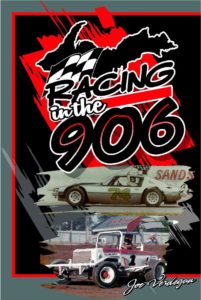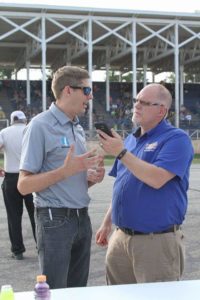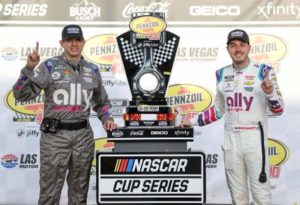The Vault
NASCAR CUP CREW CHIEF & U.P. NATIVE GREG IVES & FAMILY
Posted on: Thursday March 10, 2022
(The following excerpt is from the chapter titled “Greg Ives – Michigan Proud In Charlotte” in the 2019 release “Racing In The 906.” Since this book was released Ives was inducted into the Norway Speedway Hall of Fame in 2021.)

Order your copy of “Racing In The 906” by clicking on the “books” tab on the upper left corner of this website!
Greg and Steve Ives were born and bred into a racing family.
“I was five years old and I remember sitting in the stands with my mom eating taffy watching my dad Roger Ives race at Escanaba,” Steve Ives recalled. “It was in 1968. His car number was 111. I always rode with him when he was testing on the back roads. I remember he flew into a skid and he pulled me in, so I didn’t fly out of the car. I was hooked from that day forward.”
Roger Ives had an accident with a bulldozer that crushed his legs, but he still raced. “Dad drag raced at Great Lakes Dragaway down in Union Grove, Wisconsin and at the dragstrip in Ishpeming for a while,” Steve said. “I’d run out and stage the car while Dad worked on Gerry Olson’s car. I was eight years old. I would drive the car out to the dragstrip and help dad bleach the tires.”
For Steve Ives, though, drag racing just didn’t do it for him. “I did not want to go fast in a straight line,” Steve said. “My love was circle track racing.”
Steve bought a Ford Torino from Steve Beauchamp when he was just 14. “I raced that car number 11 at first and then upgraded to a Chevelle,” Steve recalled. “This was in the late ‘70’s. Escanaba was already an asphalt track. The racing scene was pretty solid back then. They were mixing sportsman in with the late models.”
After the ’79 season Steve made the leap to go late model. “In 1980 I bought Don Britton’s entire racing operation,” Steve recalled. “He sold me the hauler which was a one-ton truck with a camper, race car, spare motor and parts for $5,000. We were real green. We had come from a few years racing sportsman. I wanted to go to WIR in Kaukauna for their Fall Invitational. We got there late. We unloaded and I got on track for practice and my car was screaming. The RPM’s were pegged because I had Escanaba gears in it. They thought it was going to blow up. Bruce White was down there and he and a couple other guys including Terry Baldry’s dad helped change gears and I went back out. That is the most fun I ever had was the first time at WIR. I finished well. After that all I wanted to do was race at WIR.”
Work schedule and funds prevented Steve from running there weekly, but he did muster up a 19th in points one year.
Despite not having the use of his legs, Roger Ives remained the driving force behind the family’s racing. “We owe everything to dad,” Steve explained. “None of us would be racing without him.”
Over the years Steve Ives remained a front running car at Norway and recalled a very eventful feature race involving the nation’s winningest short track driver, Dick Trickle, and local legend Kent Pearson. “One night I was leading the feature when the caution came out,” Steve recalled. “I was on Dick Trickle’s bumper. I saw his eyeballs in the mirror. I passed Trickle and beat him at the line. Kent Pearson was ahead of me but was a lap down. They made a mistake and gave Kent the win. I had come from the back through the field. The fans came out of the grandstands and they were pretty upset. They grabbed the trophy right off Kent’s car. I got the win after the fact, but Kent got to celebrate the win on the track. That was probably my best memory. Dick was a racer I looked up to.”
Steve used an article about Trickle he read in Midwest Racing News to his own benefit one night at Escanaba. “I read a story once where Dick’s throttle was stuck and he used his kill switch to shut the motor off and keep running,” Steve recalled. “That happened to me the year I won the title in Escanaba in ’85. It hit me. I used the kill switch and won.”
In a time in the ‘80’s when the trend with late model motors was towards the short block, Ives stuck with a big block powerplant. “I remember one night, Duke Gardiner came up to me and said ‘son, you can’t run that big block with that many RPM’s.’ I said “Sir, yes I can, and I’ll beat you!” Duke nicknamed me ‘The Kid.’ I was the young guy they wanted to beat. I really looked up to guys like Duke, Kent (Pearson) and Joe Haferkorn. Joe was super. He’d come down and work on my race car.”
It was when Steve Ives was down and out when he found out how much his family had his back. “I was running as often as I could at WIR, Norway and Escanaba when I blew a motor,” Steve said. “I went to the bank and borrowed more money for another motor. I blew that motor. I told my dad I was done. I was flat broke, and the bank wouldn’t give me any more money.
“My Dad turned to my mom (Barb) and asked me what I needed I said I needed seven thousand dollars to finish this motor. He asked my mom if she had that much money as she was saving for a kitchen. She gave me the money. She had 13 dollars left after she loaned me that money. My parents gave everything they could for my racing.”
The Ives family was well respected in the racing circles but that didn’t mean they were immune from getting into tussles with other drivers on occasion. “I remember one night, Kent Pearson shook his fist at me and said, “I’m running you over tonight,” Steve recalled. “Dad said to me ‘take him out.’ Somebody said to Dad ‘Roger ‘your kid isn’t gonna take him out!’ I spun Kent out that night. We both went to the back. When I came into the pits Kent’s pitman Greg Gendron grabbed me and pulled me six inches off the ground! Some things I’m proud of and others I’m not so proud of.”
Steve would receive full backing even from wife Angie during his racing career. “She’d drive the hauler home from WIR just so I could get some sleep,” Steve said.
With Steve being 17 years older than Greg, Steve had his younger brother performing chores on the race car as early as five-years-old. “I’d be in there with a can of pledge and I had to clean the interior of the cars,” Greg Ives recalled. “I understood my role pretty early on. Our shop was out of our barn in the back. We were never farmers we put race cars in barns, not hay.”
At the age of 11, Greg began helping with the family business Ives Truck Repair. “We actually took a few years off from racing and put everything we had into building that business up,” Greg said. “When I was 15 my brother started racing again himself.”
One night at Norway around Greg’s 16th birthday Steve told Greg to find a pair of coveralls because he was going to make his racing debut that night at Norway. Greg started in back and wound up passing a couple of cars. After his racing debut Greg asked his dad if he could start the semi-feature where he qualified – in the front row.

Author Joe Verdegan interviews Greg Ives during a visit to Norway Speedway in 2017.
“Greg won that race,” Steve said. ‘That spurred him to go to that Duke Southard racing school down south for one week. That brought his desire to learn more. His basketball coach wasn’t happy with him because he missed it to go to that school, saying it would be one of the biggest mistakes of his life. He came home and told us we were doing a lot of things hind end backwards. He noticed we were tightening the car when we should be loosening it. Stuff like that.”
Greg at that point developed a thirst for learning absolutely everything he could about setting up a race car. “I bought my own Penske shocks and we figured out roll center and really began to understand shocks and tried rebuilding them,” Greg said. “For me it became about educating myself and trying to advance myself in other ways than driving a race car.”
Both brothers still raced and their off-track demeanors sort of mirrored how they drove. “As John Ostermann said, ‘Greg is a courteous driver and I’m not,” Steve laughed. “There is no place in racing to be courteous. There is respect. But when a hole opens up you take it, or you won’t move forward. It’s that simple.”
While it was no question Steve was the more aggressive driver of the two, Greg enjoyed longer races. “I was a good qualifying type guy,” Greg said. “I was a smooth, qualifying type driver. In those 100 lappers I’d generally come out with a pretty good finish.”
For the Ives family, once the races were done the analyzing of the evening’s events were just getting started. “We were a racing family but truthfully some of the fondest memories was not so much the racing itself but the preparation and the drive home afterwards,” Greg recalled. “We had the long driveway to back the car in. We’d get home and when we’d get in the door mom would have something ready for us to eat. Whether or was spaghetti or popcorn, we never went hungry. We’d sit on the picnic table in our kitchen and stay up until 3 a.m. sometimes talking about the races that night.”
Greg continued to race while attending college at Michigan Tech University and eventually graduated with a degree in Mechanical Engineering. As he was finishing up his schooling at tech, the family was all together at a gathering.
“Dad was sitting with one of his cousins and somebody suggested that Greg should try to get into NASCAR,” Steve recalled. “My Dad’s cousin’s daughter was married to someone who worked on Jeff Gordon’s car. It’s on the side of the family that we really don’t know that well. We all laughed and said there is no way it would happen. They setup an interview for Greg. He would eventually get hired on at an entry level position with Hendrick Motorsports as the tear down man for Jeff Gordon and Jimmie Johnson’s race cars.”
“I never went to work in racing to get rich,” Greg said. “My first job at Hendricks Motorsports I took it for $32,000 a year when I could have made twice as much as an engineer. I had some guilt initially moving away from home. I asked my mom if she wanted me to move back home and she said ‘never.’ Mom’s advice to focus on racing and getting that engineering degree helped push me along.”
The success Greg has had at NASCAR’s highest level is no surprise at all to brother Steve. “Greg is very detail oriented and always has been,” Steve said. “That’s why he’s a NASCAR crew chief at the Cup level. He was always very disciplined.”

Greg Ives (left) poses next to Alex Bowman after their NASCAR Cup victory at Las Vegas Motor Speedway in 2022. (photo courtesy of Greg Ives FB page)
It’s not an easy road to hoe at times being on the road 39 weeks out of the year. Especially when you have three young kids at home. “I’ve been doing this since 2004 and sometimes I’ve got to pinch myself because I’m working in the racing field for a living,” Greg said. “It’s an opportunity not too many people get.”
When Steve’s son Jordan was a youngster, he cut his teeth racing winged micro sprints on the dirt and sprint karts and motorcycles on the ice. “When he was 13, we’re out at Grandpa’s and he looked at my late model that Greg had refinished for us,” Steve said. “Jordan asked ‘when do I get to race this?’ My wife Angie promptly replied ‘never.’ She loved the dirt and told him he could race on the dirt all he wanted.”
Steve would wind up buying a used race car from Gene and Dickie Coleman and the teenage Jordan Ives would practice at Norway. He would eventually race a super late model for “Bullet Bob” Bordeau racing to a pair of 2nd place point finishes at Norway. As of 2019 Jordan had been running a micro sprint at U.P.I.R. in Escanaba.
One common bond the Ives family has is their strong relationship with God. “Our theme is always “With God you are always a winner,” Steve said. “Over the years I raced I kept taking the front shroud from my different race cars. It was the only thing went from car to car.”


